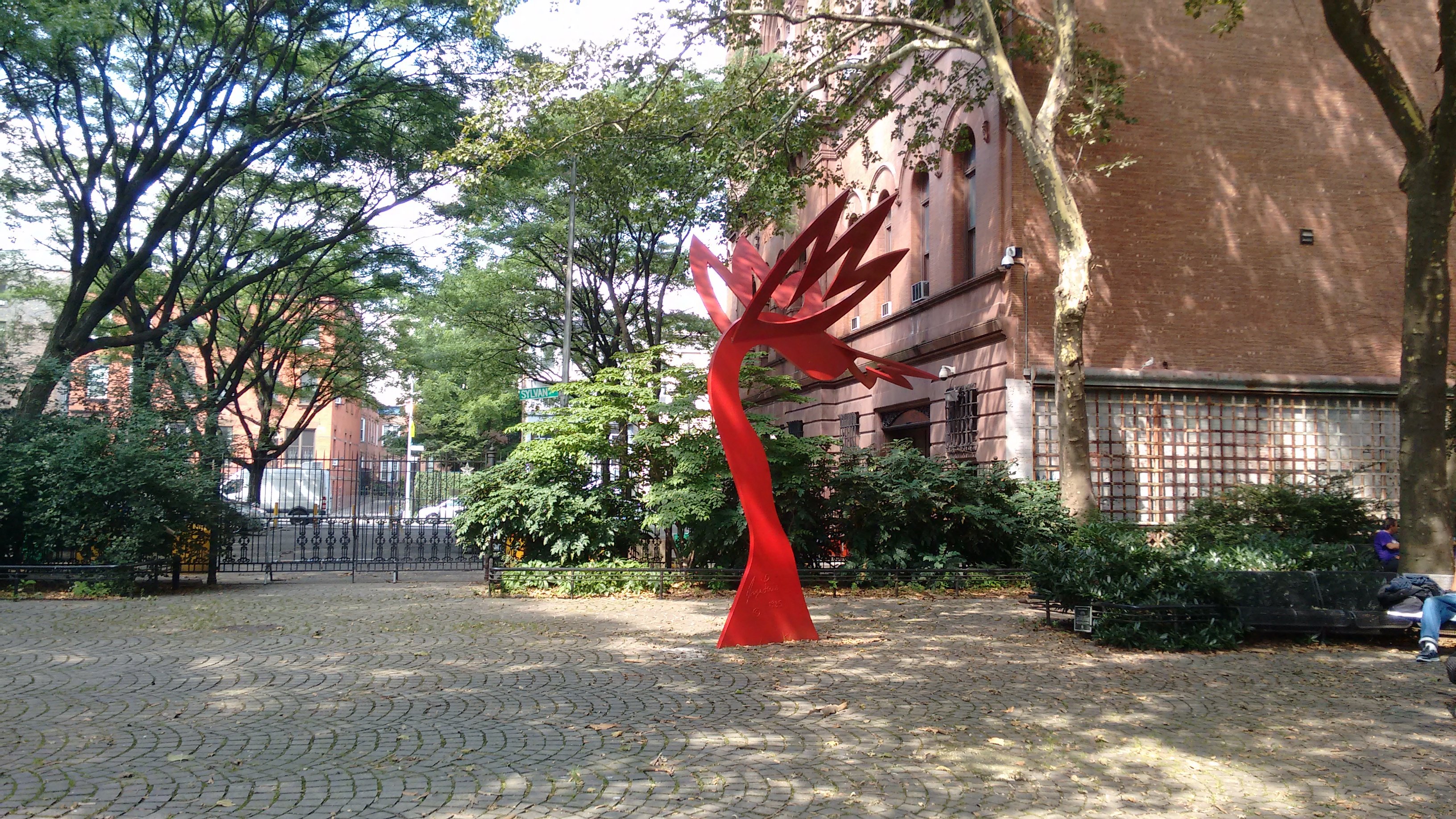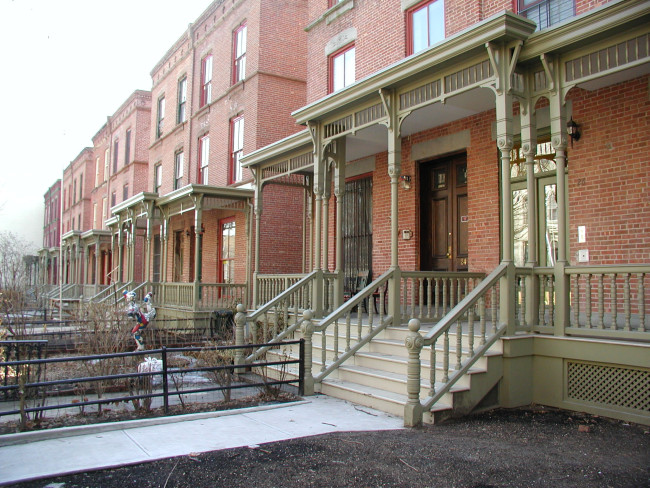A Harlem courthouse that once served as a prison still stands, with its history intact

The historic courthouse at East 121st Street in Harlem.
Photos: Marjorie Cohen
Senior court clerk Tyrone Fogle says that the building he works in—the Harlem Courthouse—is one of the best kept secrets in New York City, and he's convinced that it's one of the most beautiful. The Landmarks Preservation Commission seems to agree: “Of the many historic buildings erected in Harlem around the turn of the century and still extant, the Harlem Courthouse is one of the most significant and impressive.”
Jim Mackin, an historian who often includes the courthouse in his walking tours of the city, has similar high praise for the building’s “sublime combination of terra cotta, brownstone, granite and bluestone.” And, as for the area around the building, he says: “You won’t know you are in modern Manhattan. In fact, you may feel as though you are in the village of Harlem as it once was.”
The Courthouse is located at 170 East 121st Street in East Harlem, and since its completion in 1893, has served a variety of functions, mostly related to city government. In the beginning, it was a “one stop shop,” says Fogle. It was where, “they’d catch you, try you and jail you.” It is the oldest jail structure still standing in NYC.
And fast forward just over 100 years and now it's the home of the Harlem Community Justice Center (HCJC), which is under the aegis of the New York State Unified Court System but is designed specifically to bring the criminal justice system and community closer together. (A judge handles multi-jurisdictional issues in a single court room and on-site services are offered to address the social problems that underlie the legal issues.)
More on the building, and the surrounding neighborhood, below:
The interior and the exterior reflected the highest architectural standards of the time
The building was designed by Arthur M. Thom and James W. Wilson, principals in a firm well-known for Upper East Side row houses, the Moorish style Hampton Apartments on Perry Street and a Criminal Courthouse on Centre and Franklin Streets that has since been demolished.
Designed in the Romanesque Revival style with some elements of Victorian Gothic mixed in, it’s a four-story building, but with such high ceilings it would easily tower over any four-story building built today. One of its most beautiful features is a fifth story corner tower that's topped by eight small gables with two clocks below. The clocks are operated by gravity and it’s Fogle’s job to “wind” them by hand.
A dramatic marble and iron spiral staircase ascends from the lobby all the way to the top of the tower. Fogle said lots of visitors recognize the staircase as soon as they see it because featured prominently in the 1991 film “New Jack City." The building and the staircase is a favorite of location scouts, he added.
The wood trim on the building’s doors and windows are oak and the huge third- floor courtroom, with its vaulted ceiling and elegant proportions, is Fogle’s favorite space in the building (besides the clock tower that is).
Bugs Moran and Dutch Shultz were among the more notorious New Yorkers who were once “guests” in the building
The courthouse was built a few years before the five boroughs were consolidated into one city—at the time the city was divided into what were called Districts. The Harlem Court House served the Fifth District and was both a courthouse and a jail, with temporary holding cells. (From the court house, convicted prisoners would go to more permanent quarters on Blackwell Island).
Although the court rooms were quite grand, the cells were anything but. There were 40 cells in all with double bunk beds. Although the cells are closed off now, they are “relatively intact from a historical perspective,” according to the New York Corrections Historical Society
In its last days, it served as a women’s jail facility and it ceased all function as a jail in 1949.
Standing in the open space in front of the entrance to the building, Fogle pointed up to the top floors where the wardens and deputy wardens lived with their families. Chapel attendance was required for all of the inmates and religion was “mandatory,” he explained. "If the warden was Catholic, you were Catholic," he said.
From the same courtyard vantage point, you can see the huge wooden doors where the horse-driven paddy wagons used to back up and drop off the prisoners (pictured below).
The building is still a courthouse but what a difference a century makes
Over the years, the building has been occupied by a variety of city agencies, but since 2001 much of the space is utilized by The Harlem Community Justice Center (HCJC), which is affiliated with the Center for Court Innovation.
No longer a place where punishment is the focus, the Center focuses on solving neighborhood problems. The neighborhood is defined as the area within the 10035 and 10037 zip codes. HCJC addresses youth crime (their peer-to-peer youth court is one of their often-more replicated programs), landlord-tenant disputes (mediation is offered) and the challenges that face local parolees. Their approach is non-traditional—combining adjudication with social services in one location—and has been replicated in other parts of the country. The goal is to have the court “work together with a community to spur neighborhood renewal,” according to their website. A far cry from the paddy wagons of the past, indeed.
An exercise spot for prisoners gets a new use
Adjacent to the courthouse, with an entrance on East 120th Street, is a pleasant open space called The Harlem Art Park. It was once the exercise yard for the prisoners and Fogle pointed out that the tall fence with the iron spikes on top is original and designed to make sure that the prisoners stayed in the yard (see photo below). Despite its name, the park has only one piece of art— a stand-alone red metal sculpture—but it is a nice place to stop and rest while you’re touring the neighborhood.

A cute mews across the street gives a glimpse into what the village of Harlem looked like in the 1800s
Directly across the street from the courthouse is Sylvan Court (pictured below), a gated mews with a row of brick homes built a few years after the courthouse. (Don’t confuse this with Sylvan Terrace in Hamilton Heights, a landmarked strip that is widely known.)

A New York Times article from 1911 advises any reader who is “interested in seeing a quaint bit of old Harlem” to head to Sylvan Court.
“The court is really a blind alley as it ends in the middle of the block but there are several old-fashioned brick houses on both sides of the court and the entire atmosphere of the locality reminds one of some of the half-forgotten spots occasionally found in the Greenwich Village district,” the article states.
The reporter goes on to say that there is no section of Harlem, except perhaps “isolated portions of Pleasant Avenue...near the river that presents such a typical vision of the old days when Harlem was a village.”

You’re in luck if you’d like to live on this village-like demi-block because a home at 2 Sylvan Court is for sale. With only a few houses on the Court, this would seem to be a rare occurrence. The listing for this home recommends the triplex as a “condo alternative” with its three bedrooms, two-and-a-half baths and “intimate backyard and large roof deck.” Price tag: $1.35 million.
You Might Also Like



























